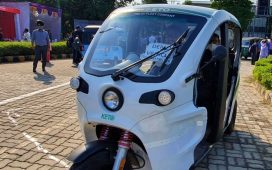COLUMBUS, Ohio – In the fall of 2024, Cleveland Metropolitan School District buses didn’t pick up or take home four students with disabilities who attend a private school in Independence, as required under state law.
The district paid for not complying — and it’s not the only one.
Ohio’s pupil transportation law generally requires school districts to transport students who live inside the district’s boundaries to charter and private schools – even if those schools are located outside of the district, if the ride isn’t more than 30 minutes.
The state deducted $177,764.50 from CMSD’s transportation payments this school year, a relatively small chunk of the $17 million it was set to receive.
Columbus lost $1.1 million, Cincinnati was deducted $547,000 and Dayton was docked $135,000, said Jennie Stump, the Ohio Department of Education and Workforce’s chief of policy and legislative affairs, during an Ohio Senate legislative committee.
School district officials say transportation has become a challenge in recent years – from finding bus drivers to rising fuel costs.
Increased school choice has added to districts’ transportation burdens. In some school districts, more buses take students to charter and private schools than to the district’s public schools. Ohio’s requirement to transport students outside district boundaries contributes to this burden and makes it unique among states.
The Ohio House’s version of the two-year state budget provides more money for transportation, though it won’t fully reimburse some districts for their costs for private and charter school transportation, said Doug Palmer, the Ohio School Boards Association’s senior transportation consultant.
The House proposal would provide $874 million for transportation in the fiscal year that begins July 1. That’s an increase over existing levels, but 0.4% less than Gov. Mike DeWine’s budget proposal.
For the following fiscal year, the House proposes $941.4 million in transportation funds, 1.5% less than what DeWine proposed.
For comparison, districts are expected to receive $819.8 million when the current school year ends.
The budget is now being considered in the Senate. The legislature is expected to pass it by July 1, when the next fiscal year begins.
The House’s version of the budget also provides flexibility for school districts to enter contracts with ridesharing companies, such as Uber or Lyft. It creates a transportation workgroup to develop recommendations on how to better meet students’ needs.
Cleveland students stranded
State law generally requires districts to transport K-8 students who live more than two miles from a charter or private school. Districts are not required to haul students for more than 30 minutes.
Districts can choose to transport students in grades 9-12 to district, charter and private schools, the law states.
The law also requires districts to provide transportation for all children with disabilities living in the school district who are enrolled in a private school if the school district is provided documentation about their learning needs.
The stranded students in September and October 2024 attended New Story Schools-Independence, which specializes in the education of students with autism and emotional support needs.
CMSD spokesmen did not answer questions about why the district didn’t provide busing at the beginning of last school year. New Story also did not respond to a message.
Attorneys for the Legal Aid Society of Cleveland submitted two complaints to DEW on behalf of four students.
In one complaint, filed Sept. 27, 2024, three children were supposed to begin at New Story in three days. They had not received bus route information from CMSD. The district didn’t respond to two emails from the lawyer.
The other complaint, dated Oct. 24, 2024, was on behalf of a separate child at the school. An adult originally reached out to CMSD to request transportation for the child on Aug. 26, 2024.
“Despite many follow up attempts via email, the transportation has not been put in place,” the complaint said.
DEW investigated and assessed the fine in the form of a discount of future funds.
State Sen. Andrew Brenner, a Delaware County Republican who chairs the chamber’s education committee, said the Cleveland parents shouldn’t have had to get help from Legal Aid.
“The fact that they had to go that length, are they that incompetent that they can’t return a phone call? That would be the question I have,” he said. “If they are, maybe they shouldn’t be in charge.”
For its version of the budget, the Senate is evaluating the levels of transportation funding for districts, Brenner said. It is considering pilot projects in some counties, creating countywide school transportation offices that would design routes to get all eligible students to school.
The Senate is likely to adopt the transportation workgroup proposed by the House, he said. This was requested by the Ohio School Boards Association, the Buckeye Associations of School Administrators and the Ohio Association of School Business Officials.
Seeking Supreme Court order
Ohio Attorney General Dave Yost, a Republican, sued the Columbus City School District, asking the Ohio Supreme Court in a Sept. 5, 2024, emergency request to force it to bus “hundreds – possibly in excess of one thousand” charter and private school students that the district wasn’t transporting.
Columbus schools argued it was contending with a bus driver shortage and more complicated bus schedules due to school choice. It said many of the students who it cut off from transportation would have required a ride of over 30 minutes, so they were not required by law to drive them.
State pupil transportation law allows districts to decide it’s impractical to transport a pupil based on the time and distance of transportation, the number of students who need transportation, the cost of providing transportation and other reasons.
But the school board was required by the law to notify families at least 30 days before the first day of school, which Yost said Columbus did not do.
After Yost sued, the district created new routes to cover some of the students.
The Ohio Supreme Court dismissed Yost’s motion about a month later, without providing an explanation.
Palmer, the Ohio School Boards Association’s transportation consultant, said that making the 30-day cutoff can be hard for school boards. The district transportation offices often don’t finalize their routes until the second or third week of July. They are waiting for the main office to notify them of how many students will be attending each building.
Bus driver retirement
The average age of a bus driver nationwide in 2023 was 57. Many drivers are in their 60s and 70s, Palmer said.
“We have more drivers retiring every year than they can hire,” Palmer said. “So some of the biggest school districts are losing 14% to 15% of drivers a year that they can’t replace.”
Many drivers and substitute drivers left the profession when schools closed during the beginning of COVID-19, he said.
If someone calls in sick, districts scramble. Transportation managers, school secretaries and even principals that have CDLs jump behind the wheel to get kids to school, he said.
Palmer has suggested a solution to the difficulty of running buses for private and charter schools – allow them to purchase buses and design their own routes. Under current law, Palmer said this is permitted, but no districts or private schools have tried it yet.
This could especially be successful in faith-based private schools, since they can draw bus drivers from a different pool of people than school districts: Congregants, school staff, parents and volunteers.
Since training and running a bus maintenance garage may be expensive for a small school, they can contract with the local district for those services.
The 6,000 to 7,000 bus drivers represented by the Ohio Association of Public School Employees are happy to drive charter and private school students, said Joe Rugola, the union’s executive director.
The question is whether there’s sufficient funding.
“Our view is that the transportation operations are still going to be underfunded with the amounts we’re talking about in the budget,” Rugola said.
Drivers are worried about vacancies. If there was more money, they’d want a second adult on each bus to mind the students. That would free the driver of student distractions.
“I’ve often joked with public officials that if they wanted an experience, they should lock themselves on a school bus, rolling down the road at 50 mph with 50 junior high students behind them,” he said. “It would change a lot of people’s perspectives.”
Laura Hancock covers state government and politics for The Plain Dealer and cleveland.com.









